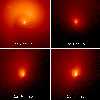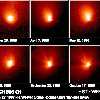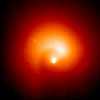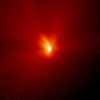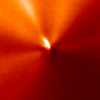March 27, 1997
This is a series of Hubble Space Telescope observations of the region around the nucleus of Hale-Bopp, taken on eight different dates since September 1995. They chronicle changes in the evolution of the nucleus as it moves ever closer to, and is warmed by, the sun.
Figure 1: HST images of Hale-Bopp on 8 different dates. All images were interpolated to the same spatial scale of 470 km/pixel (each image covers a distance of ~33,000 km at the comet), normalized to the same peak pixel intensity, and are displayed using the same logarithmic intensity scale. In all images, celestial north is straight up (vertical direction) and east is to the left. The image from 26 September 1995 was taken ~60 hrs after a strong dust outburst and shows a spiral arm wrapping around the nucleus. The images in the fall of 1996 show multiple jets that are presumably connected to the activation of multiple vents on the surface of the nucleus. The image from 7 April 1996 was slightly trailed due to poor tracking.
Figure 2: The same as Figure 1 above, except using a different color stretch so that the core of the image is a little "bloomed out". Most people find this version to be a bit more visually pleasing than the one above. However, the image in Figure 1 is scientifically more valuable.
Figure 3: This is an HST image of Hale-Bopp taken on 26 September 1995 with the WFPC2 in wide-field camera mode. The frame is about 10 arcsec across, which corresponds to 47,000 km at the comet. Serendipitously, we caught the comet only ~60 hrs after a large outburst, and we see the magnificent spiral arm that results.
Figure 4: This is an HST image of Hale-Bopp taken on 23 September 1996 with the WFPC2 in planetary camera mode. The frame is 10.9 arcsec across, which corresponds to 23,360 km at the comet. The shape of the coma at this time is very different from what was observed a year earlier (in 1995). Instead of seeing a single strong jet and its associated spiral structure, the comet now has sprouted several jets, making it look more like a porcupine.
Figure 5: This is the same data as for the preceeding image, except that we divided by an azimuthally-averaged Hale-Bopp image. This technique emphasizes the jet structure and also removes the steep brightness drop-off as you move away from the nucleus.
In this image, the nucleus is at the very center of the frame, just below and to the right of the very strong jet near 11 o'clock. Apparently there was an outburst in this direction shortly before our observations. Farther out there is another bright region that must be the remnant of an even earlier outburst. Several weaker jets (at 10 o'clock, 7:30, 3 o'clock, and 1 o'clock; celestial North is at 12 o'clock and East is at 9 o'clock) are also visible. This image demonstrates graphically that Hale-Bopp's nucleus must be a very dynamic place. The frame is 10.9 arcsec across, which corresponds to 23,360 km at the comet during these September 1996 observations. The length of the "white" jet emanating at 11 o'clock is 0.96 arcsec (2050 km at the comet).
Credits: Harold Weaver (Johns Hopkins University) and NASA
